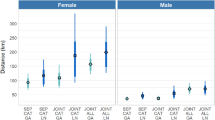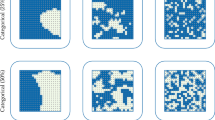Abstract
We provide an integrated capture–recapture–recovery framework for partially monitored populations. In these studies, live resightings are only observable at a set of monitored locations, so that if an individual leaves these specific locations, they become unavailable for capture. Additional ring-recovery data reduce the corresponding bias obtained in the survival probability estimates from capture–recapture data due to the confounding with colony dispersal. We derive an explicit efficient likelihood expression for the integrated capture–recapture–recovery data, and state the associated sufficient statistics. We demonstrate the significant improvements in the estimation of the survival probabilities using the integrated approach for a colony of guillemots (Uria aalge), where we additionally specify a hierarchical approach to deal with low sample size over the early period of the study.
Supplementary materials accompanying this paper appear online.


Similar content being viewed by others
Change history
10 May 2021
A Correction to this paper has been published: https://doi.org/10.1007/s13253-021-00453-3
References
Abadi F, Gimenez O, Ullrich B, Arlettaz R, Schaub M (2010) Estimation of immigration rate using integrated population models. J Appl Ecol 47:393–400
Barker R (1999) Joint analysis of mark-recapture, resighting and ring-recovery data with age-dependence and marking-effect. Bird Study 46:82–91
Besbeas P, Freeman SN, Morgan BJT, Catchpole EA (2002) Integrating mark-recapture-recovery and census data to estimate animal abundance and demographic parameters. Biometrics 58:540–547
Birkhead TR, Hudson PJ (1977) Population parameters for the common murre Uria aalge. Ornis Scandinavica, 145–154
Bonner S, Morgan BJT, King R (2010) Continuous covariates in mark-recapture-recovery analysis: a comparison of methods. Biometrics 66:1256–1265
Burnham K (1993) A theory for combined analyis of ring recovery and recapture data. In: Lebreton JD, North PM (eds) Marked individuals in the study of bird population. Birkhäuser, Basel, pp 199–213
Catchpole E, Freeman SN, Morgan BJT, Harris MP (1998) Integrated recovery/recapture data analysis. Biometrics 54:33–46
Catchpole EA, Morgan BJT, Tavecchia J (2008) A new method for analysing discrete life history data with missing covariate values. J R Stat Soc Ser B 70:445–460
Conn PB, Johnson DS, Williams PJ, Melin SR, Hooten MB (2018) A guide to Bayesian model checking for ecologists. Ecol Monogr 88:526–542
Crespin L, Harris MP, Lebreton J-D, Frederiksen M, Wanless S (2006) Recruitment to a seabird population depends on environmental factors and on population size. J Anim Ecol 75(1):228–238
Gelman A, Carlin JB, Stern HS, Dunson DB, Vehtari A, Rubin DB (2013) Bayesian data analysis. CRC Press, Boca Raton
Glennie R, Buckland ST, Langrock R, Gerrodette T, Ballance LT, Chivers SJ, Scott MD (2020) Incorporating animal movement into distance sampling. J Am Stat Assoc. (in press)
Guillera-Arroita G, Lahoz-Monfort JJ, van Rooyen AR, Weeks AR, Tingley R (2017) Dealing with false-positive and false-negative errors about species occurrence at multiple levels. Methods Ecol Evol 8:1081–1091
Halley DJ, Harris MP, Wanless S (1995) Colony attendance patterns and recruitment in inmature common murres (Uria aalge). The Auk 112(4):647–957
Harris MP, Frederiksen M, Wanless S (2007) Within-and between-year variation in the juvenile survival of common guillemots Uria aalge. Ibis 149:472–481
Hubbard BA, Cole DJ, Morgan BJT (2014) Parameter redundancy in capture-recapture-recovery models. Stat Methodol 17:17–29
Kadin M (2007) Post-fledging survival and sexual maturation in common guillemots Uria aalge—the influence of biological and ecological factors. Master’s thesis, Department of Systems Ecology, Stockholm University, Stockholm
King R (2012) A review of Bayesian state-space modelling of capture-recapture-recovery data. Interface Focus 2:190–204
King R (2014) Statistical ecology. Ann Rev Stat Appl 1:401–426
King R, Brooks SP (2003) Closed-form likelihoods for Arnason-Schwarz models. Biometrika 90:435–444
King R, McCrea R (2014) A generalised likelihood framework for partially observed capture–recapture-recovery models. Stat Methodol 17:30–45
King R, Brooks SP, Mazzetta C, Freeman SN, Morgan BJT (2008) Identifying and diagnosing population declines: a Bayesian assessment of lapwings in the UK. J R Stat Soc Ser C 57:609–32
King R, Morgan BJT, Giménez O, Brooks SP (2010) Bayesian analysis for population ecology. CRC Press, Boca Raton
Langrock R, King R (2013) Maximum likelihood estimation of mark-recapture-recovery models in the presence of continuous covariates. Ann Appl Stat 7:1709–1732
Lebreton JD, Burnham KP, Clobert J, Anderson DR (1992) Modeling survival and testing biological hypotheses using marked animals: a unified approach with case studies. Ecol Monogr 62:67–118
McClintock BT, Langrock R, Gimenez O, Cam E, Borchers DL, Glennie R, Patterson TA (2021) Uncovering ecological state dynamics with hidden Markov models. Ecol Lett
McCrea R, Morgan BJT (2015) Analysis of capture-recapture data. CRC Press, Boca Raton
McCrea R, Morgan BJT, Giménez O, Besbeas PB (2010) Multi-site integrated population modelling. J Agric Biol Environ Stat 15:539–561
McCrea R, Morgan BJT, Giménez O, Bregnballe T (2012) Model comparison and assessment for multi-state capture–recapture-recovery models. J Ornithol 152(Suppl. 2):293–303
Olsson O, Hentati-Sundberg J (2017) Population trends and status of four seabird species (Uria aalge, Alca torda, Larus fuscus, Larus argentatus) at Stora Karlsö in the Baltic sea. Ornys Svecica 27:64–93
Oro D, Pradel R (2000) Determinants of local recruitment in a growing colony of Audouin’s gull. J Anim Ecol 69:119–132
Österblom H, Van der Jeugd HP, Olsson O (2004) Adult survival and avian cholera in Common Guillemots Uria aalge in the Baltic Sea. Ibis 146:1–4
Plummer M (2003) JAGS: a program for analysis of Bayesian graphical models using Gibbs sampling. In: Proceedings of the 3rd international workshop on distributed statistical computing, vol 124, pp 1–9
Reynolds T, King R, Harwood J, Frederiksen M, Harris M, Wanless S (2009) Integrated data analysis in the presence of emigration and mark loss. J Agric Biol Environ Stat 14:411–431
Sanz-Aguilar A, Igual JM, Oro D, Genovart M, Tavecchia G (2016) Estimating recruitment and survival in partially monitored populations. J Appl Ecol 53:73–82
Sarzo B, Armero C, Conesa D, Hentati-Sundberg J, Olsson O (2019) Bayesian immature survival analysis of the largest colony of Common murre Uria aalge in the Baltic sea. Waterbirds 42:304–313
Schaub M, Abadi F (2011) Integrated population models: a novel analysis framework for deeper insights into population dynamics. J Ornithol Suppl 1(152):S227–S237
Seber G, Schofield M (2019) Capture–recapture: parameter estimation for open animal populations. Springer, Cham
Sollmann R, Gardner B, Parsons AW, Stocking JJ, McClintock BT, Simons TR, Pollock KH, O’Connell AF (2013) A spatial mark-resight model augmented with telemetry data. Ecology 94:553–559
Votier SC, Birkhead TR, Oro D, Trinder M, Grantham M, Clark JA, McCleery RH, Hatchwell BJ (2008) Recruitment and survival of immature seabirds in relation to oil spills and climate variability. J Anim Ecol 77(5):974–983
Author information
Authors and Affiliations
Corresponding author
Additional information
Publisher's Note
Springer Nature remains neutral with regard to jurisdictional claims in published maps and institutional affiliations.
Electronic supplementary material
Below is the link to the electronic supplementary material.
Rights and permissions
About this article
Cite this article
Sarzo, B., King, R., Conesa, D. et al. Correcting Bias in Survival Probabilities for Partially Monitored Populations via Integrated Models. JABES 26, 200–219 (2021). https://doi.org/10.1007/s13253-020-00423-1
Received:
Accepted:
Published:
Issue Date:
DOI: https://doi.org/10.1007/s13253-020-00423-1




